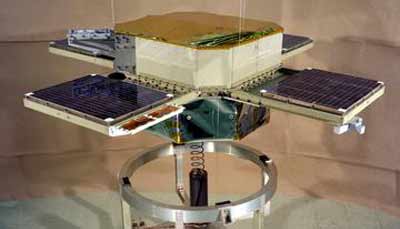Thank you very much for visiting Gunter's Space Page. I hope that this site is useful and informative for you.
If you appreciate the information provided on this site, please consider supporting my work by making a simple and secure donation via PayPal. Please help to run the website and keep everything free of charge. Thank you very much.
SPHINX A, B, C

SPHINX [NASA]
SPHINX (Space Plasma High-Voltage Interaction Experiment) was a self-contained satellite which was designed to obtain engineering data necessary to design high-voltage systems that could be exposed directly to a space environment.
For this project, a single satellite launch was planned. During ascent, the Sphinx spacecraft was to be supported on top of the Viking Dynamic Simulator (VDS), the prime payload for this flight. The Sphinx satellite was to be ejected from the VDS at a velocity greater than two feet per sec and at a spin rate of approximately 30 rpm. The satellite would have been positioned initially so that the spin vector was toward the sun. The release of the sphinx was to be after the third burn of the Centaur, and was controlled by the Centaur event timer.
The following specific areas were to be investigated:
- measuring the plasma coupling current between the space plasma and surfaces elevated to various electrical potentials;
- determining the short-term and long-term effectiveness of insulating conductors biased to various voltages;
- determining the effect of the operating voltage on solar cell performance;
- studying the influence of the space plasma on the surface resistance of various dielectrics; and,
- performing long-duration studies on the electrical breakdown of and the stability of imperfections in insulating materials.
The spacecraft failed to achieve orbit following launch due to Centaur upper stage malfunction.
Two more satellites called SPHINX B and C were to be launched in the early 80ies. SPHINX B would have been a repeat of SPHINX A, while SPHINX C would also have tested an ion engine. They would have been launched either individually as a piggy back payload on a Shuttle IUS mission or together on a dedicated Delta launcher with an apogee kick motor. Both satellites were cancelled.
| Nation: | USA |
|---|---|
| Type / Application: | Technology Plasma interactions |
| Operator: | NASA |
| Contractors: | NASA Lewis |
| Equipment: | |
| Configuration: | Spin stabilized |
| Propulsion: | None (#A, #B); ion thuster (#C) |
| Power: | 4 fixed solar arrays, batteries |
| Lifetime: | 1 year |
| Mass: | 113 kg |
| Orbit: | 880 km × 34300 km, ?° (planned) |
| Satellite | COSPAR | Date | LS | Launch Vehicle | Remarks | |
|---|---|---|---|---|---|---|
| SPHINX A | 1974-F01 | 11.02.1974 | CC LC-41 | F | Titan-3E Centaur-D1T | with Viking-DS |
| SPHINX B | - | cancelled | CC | Shuttle [IUS] (baselined) | with ? | |
| SPHINX C | - | cancelled | CC | Shuttle [IUS] (baselined) | with ? |
References:
- N. John Stevens, Solar array experiments on the Sphinx satellite, November 1973
- NSSDC Master Catalog: Sphinx
- NSSDC Master Catalog: Sphinx-B
- NSSDC Master Catalog: Sphinx-C
